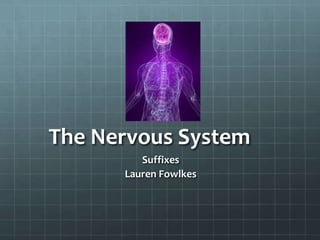
Fowlkesch12
- 1. The Nervous System Suffixes Lauren Fowlkes
- 2. Suffixes This presentation will explore the suffixes of –algesia and –esthesia -algesia is the suffix meaning pain or sensitivity to pain. -esthesia means feeling or sensation.
- 3. -Algesia Common Terms Analgesia- the absence of pain or sensation Hypalgesia- a decreased sensitivity to painful stimuli Hyperalgesia- an increased sensitivity to painful stimuli Neuroleptanalgesia- a state of quiescence, altered awareness and analgesia produced by the combination of opioid and neuroleptic
- 4. -Esthesia Common Words Anesthesia- a lack of sensations Hyperesthesia- the condition of excessive sensations Kinesthesia- the sense that detects the body position, weight, or movement Paresthesia- an abnormal sensation such as burning or itching Synesthesia- stimulation of one sensory or cognitive pathway leads to automatic, involuntary experiences in a second sensory or cognitive pathway
- 5. Anesthesia and Analgesia Anesthesia and Analgesia are by far the most common terms out of those listed on the previous slides. Anesthesia and analgesia form a very important medical specialty that we call anesthesiology. A variety of drugs are used to block patients pain receptors, memory, responsiveness and/or muscle control. This specialty allows patients to undergo surgery or other procedures without experiencing the pain and discomfort they typically would in absence of these pharmacological agents. Anesthesia and analgesia have advanced medicine substantially.
- 6. Types of Anesthesia Local Anesthesia- inhibits sensory reception on a specific location of the body (ex. Tooth or urinary bladder) Regional Anesthesia- inhibits sensation in a larger area of the body by blocking nerve impulses from that part of the body and the spinal cord General Anesthesia- inhibits sensory, motor and sympathetic nerve transmission at the level of the brain, which produces lack of sensation and unconsciousness
- 7. Anesthetics Anesthetics are drugs that produce a loss of sensation or consciousness. Lidocaine Xylocaine Propofol Diprivan Procaine Sevoflurane Desflurane Isoflurane
- 8. Analgesics Analgesics are medications that treat pain. They are split into two groups, non-narcotic and narcotics. Non-narcotics are used for minor to moderate pain. They include aspirin, acetaminophen and ibuprofen. Narcotics are used for severe pain relief and patients must use caution because they are addictive. They are collectively called opiates and some common ones are morphine, oxycodone, Demerol and OxyContin.